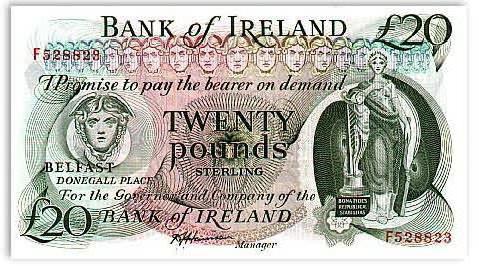
Since 2002, the currency of Ireland is the euro. On coins that are circulating in this country, the local state symbol is depicted. And until 2002, the Irish pound was considered national money here. Why has the currency of Ireland changed so much? For a long time the country did not have its own money at all. They appeared only at the end of the 10th century.

The first Irish coins appeared in 997. They were taken from England. Therefore, the coin was 1 pound sterling. Yes, and the division of new money was identical, as with the English currency. So, the Irish pound was equal to exactly 20 shillings. And 1 shilling was equal to 12 pence.
Over time, the Irish pound fell in pricerelation to English. Entrepreneurs constantly tried to equalize them. However, these actions were unsuccessful. As a result, by the beginning of the 18th century, 13 copper Irish pence coins were equal to the silver schilling of England. In Ireland, on silver, money was not minted.
In 1823, the last Irish coins were issued. Further banks began to print already paper money. And Ireland did not own coins.
Only with the attainment of independence has the national currency of Ireland reappeared. However, in the 1960s it was necessary to switch to a decimal system. Accordingly, 1 pound was equal to 100 pence.
In 2002, the Irish pound was replaced by the euro. Local residents in the first 2 weeks exchanged more than 50% of the entire money supply. Until now, the Irish coins and banknotes, which were issued after 1928, can be exchanged for the euro. Only does it the Central Bank of the country, located in Dublin.

When moving to euro currency of Irelandexchanged, based on the rate of 1 euro + 0.7876 pounds. It was in this country that the most rapid transition to EU money occurred. And this is due to the fact that a very competent information policy on this topic was organized in Ireland. The population was given out booklets, on television they launched social advertising, conducted special training.
As in all countries that are members of the European Union, coins are minted in Ireland, which have:
Despite the fact that Ireland has long been switched tothe situation in Northern Ireland is quite different. So, the local currency is a pound sterling, which is equal to 100 pence. Today in everyday life there are banknotes of several denominations:
There are also coins:
The fact is that historically Northern Ireland is part of the UK. Accordingly, the currency of Ireland does not go there.

Traveling around the EU, all are calculated euro. Arriving in Ireland, there is no need to change the currency either. And in the shops, and in museums, and in restaurants will take the euro. In institutions of the service sector, you can pay by credit card. And if necessary, make a currency exchange can be in any bank. On the street, random walkers should not do this. Otherwise, there is a probability of being deceived by swindlers (they will make an exchange at a rate unprofitable for a tourist or issue fake banknotes). Therefore, it is better to focus on the official and large banking organizations in the country.
